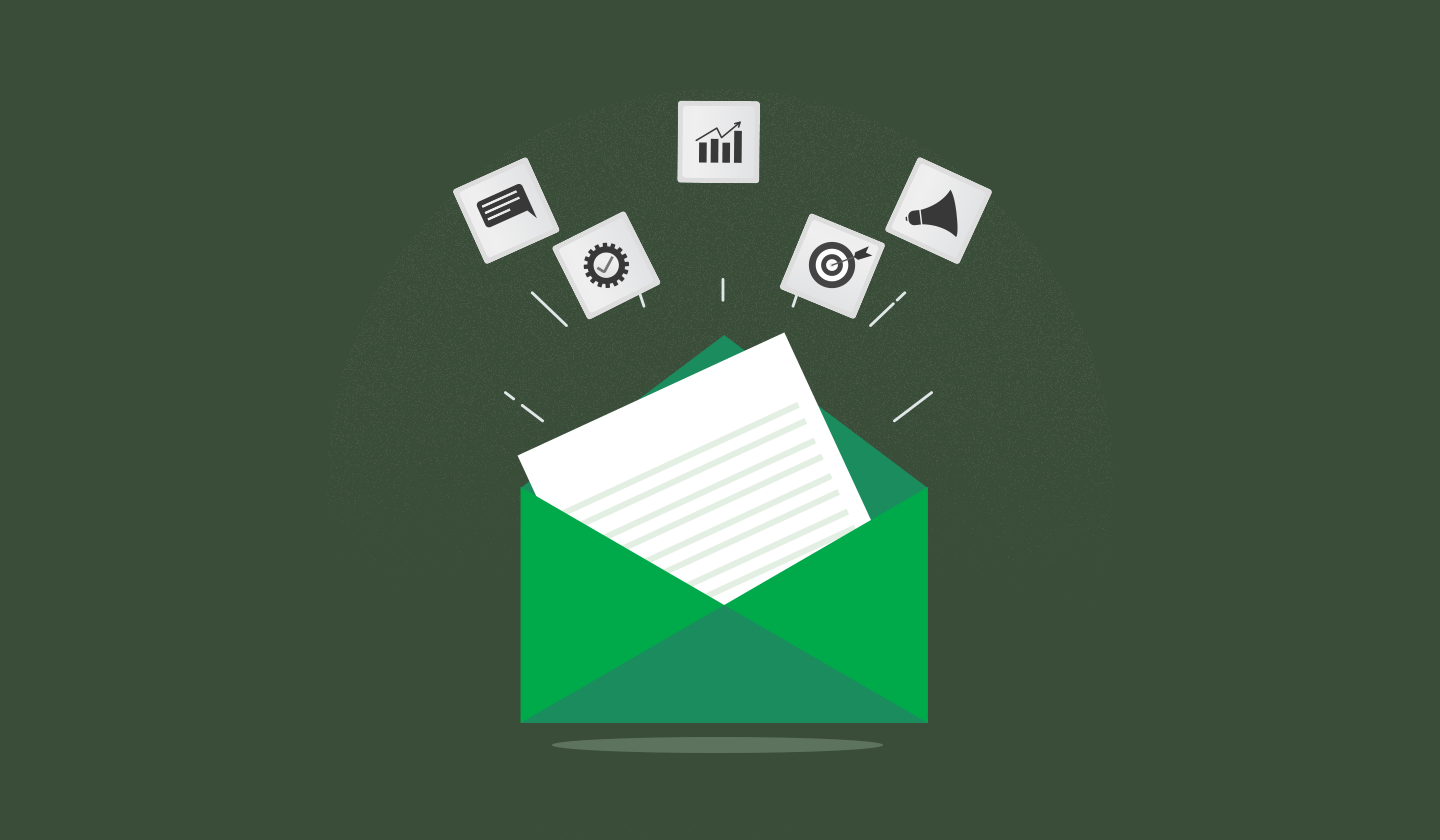In an increasingly competitive email marketing landscape, getting your email campaigns right is key to achieving success.
With so many variables and considerations to take into account when crafting emails for your audience, having a quick email marketing checklist can help you ensure that nothing slips through the cracks and that all of the essential elements are present in each message.
From making sure your subject line is catchy to ensuring you've included a CTA (call-to-action), there's no shortage of things to keep track of when it comes to email marketing.
A comprehensive yet concise checklist can help streamline this process and ensure everything is taken care of before sending out any messages.
So, let’s get started.
1. Define Clear Goals for Your Email Campaigns
Before launching any campaign, you need to determine the specific objectives of your email marketing efforts. These should be measurable and actionable, such as increasing website visits or sales conversions.
Email marketing campaigns can have a wide range of goals, depending on the type of product or service being promoted.
Suppose an online retailer is trying to increase sales. In that case, its primary goal might be to drive more traffic to its website and convince customers to purchase products through email campaigns with strategic offers such as discounts, free shipping, and money-back guarantees.
On the other hand, a company that provides software services might focus more on lead generation, connecting with potential customers through personalized content, and responding quickly to inquiries via email.
Whatever your email marketing goals are, always remember what you’re trying to accomplish with those, such as:
Boosting sales.
Customer retention.
Nurturing potential leads.
Upsell.
Cross-sell.
Gathering data about your customers.
2. Master the Art of Compelling Subject Lines and Preheader Text
You shouldn’t judge a book by its cover, but that’s not the case for email subject lines because they determine whether a recipient will open your email.
Therefore, you need to put more effort into crafting eye-catching subject lines and preheader text that compliments those subject lines. Why? Because subject lines without preheader text don’t look very nice.

Here are a few tips to keep in mind when crafting your email subject lines and preheader text:
See if your subject line and preheader text serves the purpose of your email smartly and precisely.
Keep it short and sweet.
Double-check for spelling.
Add a sense of urgency.
Experiment with new ideas every now and then.
Avoid spammy elements like ALL CAPS and excessive exclamation marks.
Related: 105 Email Subject Line Examples You Need To Copy This Minute
3. Regularly Clean Your Email List
Keeping a clean email list is essential for successful email marketing campaigns and long-term customer relationships.
By following the below best practices, you can ensure your email list is squeaky clean:
Remove duplicate email addresses.
Identify inactive subscribers.
Update existing contact information.
Unsubscribe participants from previous campaigns.
Validate all email addresses.
Remove unsubscribed and bounced contacts.
Clean up automated signups.
Merge profile data with contact info.
Run a spam filter check before sending out emails.
Replace invalid or misspelled email addresses.
Use a double opt-in system for email signups.
4. Segment Your Target Audience
To maximize the effectiveness of your email marketing efforts, it is important to carefully segment your target audience into smaller, more focused groups.
By creating a segmented audience, you can create tailored messages that are more likely to resonate with your recipients, resulting in higher engagement and better ROI results.
You can segment your target audience on the basis of the following:
Age.
Gender.
Location.
Lifestyle factors like interests, hobbies, values, and beliefs.
Customers’ past purchase history.
Website visits.

5. Refine Your Email Copy
Writing an enticing email copy can be a daunting task for email marketers. However, following a small checklist to get your email copy right will take you on the right path.
To achieve this:
Focus on crafting a clear Call-To-Action.
Use persuasive language to get readers to take action.
Provide valuable content that resonates with your audience.
Keep it conversational by using the words “I” and “you.”
Avoid industry jargon. Instead, focus on pain points.
Keep things short and concise.
Avoid big blocks of text. Break them into smaller chunks.
Ensure your content is relevant.
6. Polish Your Email Design
The overall email design is as important as the email copy because the strategic placement of different elements results in greater email engagement, lead generation, and conversions.

Here’s what you need to keep in mind while designing your emails:
Use pre-made email templates.
Use headings to convey your message clearly.
Try to use center alignment for your headings.
Add visuals that support your text.
Visuals can be anything from images, emojis, and icons to videos.
Don’t overdecorate your text.
Use fonts that compliment your brand’s tone.
Remember to add your brand logo in your header.
Add contact information, including address and phone number, social media icons, and unsubscribe option in your email footer.
Use single-column layouts because these are easier to navigate.
Play smartly with the white spaces.
Make sure your CTA stands out from the rest of your email.
Related: The Ultimate Guide to Email Design Best Practices in 2023
Why choose Unlayer for designing your emails?
Unlayer is an ideal choice for email design since it allows you to quickly and easily create visually-stunning, responsive emails.
You can quickly build beautiful emails from scratch or customize one of the many templates available.
It takes less than 5 minutes to embed the editor in your application.
It’s highly configurable and fully white-labeled.
It offers a suite of features that make creating custom designs easy and efficient.
The drag-and-drop editor lets you add elements such as images, GIFs, videos, text blocks, and more to your email without needing coding knowledge.
You can also customize font sizes and colors and change layouts for different devices.
In addition, it offers integrations with several email service providers like Gmail, ActiveCampaign, etc.
For those looking for extra support in their email creation process, it also provides customer service with dedicated support engineers always ready to help with any question or issue.
With all these features and services in one place, Unlayer makes it simple to build creative and effective emails that stand out in any inbox.
7. See How Your Emails Render on Different Devices
Since 81% of users prefer to view their emails on mobile phones, having a responsive email design is a must.
These are the responsive email design best practices that you should follow to ensure your emails are flexible and adapt to various screen sizes.
Test your email design in multiple clients and browsers.
Make sure all text is legible on mobile devices.
Use a single-column layout with stacked blocks for the best mobile design compatibility.
Utilize CSS media queries to adjust content based on display size.
Set font sizes and line heights to be responsive as well. At least use 13- or 14-pt font for the body text and 20-pt for the titles.

Set max widths so that images don’t overflow their containers.
Optimize images for smaller screen sizes.
Use alt text for images in case an email client doesn’t load your images.
Leave plenty of white space around elements in order to improve overall readability.
Avoid cluttering several hyperlinks together. Instead, use big, tappable buttons.
8. Choose the Right Sending Time
When it comes to email marketing, getting your email timing right is essential. Why? Because a wishy-washy email marketing strategy doesn’t work.
Therefore, you need to follow these tips to get your email timing right.
Know your email’s purpose.
Research when to send emails.
Create a schedule of email sends.
Test different times and days for sending emails.
Track the results of each send.
Analyze clicks, conversion rates, overall ROI, etc.
Adjust as needed.
9. Enable A/B Testing
A/B testing gives you an opportunity to experiment with content while also learning more about your customers’ preferences.
With careful analysis of test results and thoughtful tweaking of emails based on data collected from these tests, you can optimize your email campaigns for higher engagement rates and improved customer experiences.
You can run A/B tests on a variety of elements within your emails, including subject lines, preheader text, images, colors, copy length, CTAs, and more.
Here are a few things to keep in mind while enabling A/B testing for your email campaigns.
Set the goals of your A/B testing.
Choose which elements to test.
Test one element at a time.
Determine the sample size and time frame for running tests.
Split your list randomly.
Make one copy of the original email version.
Create a second version of the email with the changes you want to test.
Send both versions to your list, making sure each group is equally sized.
Track key metrics like click-through rate, conversions, etc.
Monitor results throughout the duration of your experiment.
Analyze data and draw conclusions from your findings.
Implement learnings into future campaigns.

Pro tip: Send a test email to another person within your marketing team to help you catch something glaring before it’s too late.
10. Track Email Marketing KPIs
Now that you have created the perfect email and sent that to your subscribers, your job is not done yet.
It’s time to see whether you have achieved your email marketing goals or not. There are a number of email marketing KPIs you should be tracking like:
Email deliverability rate.
Click-through rate.
Conversion rate.
Unsubscribe rate.
Bounce rate.
Spam complaint rate.
Email sharing rate.
List growth rate.
Return on investment.
Revenue per email.
Revenue per subscriber.
Conclusion
Email marketing can be a powerful tool for your business, but it’s important to make sure you get the basics right.
We hope this quick email marketing checklist has given you some useful tips and ideas on how to create effective emails that are tailored to your customers' needs.
By following these steps, you’ll ensure that every email campaign is successful and well-received by your audience.
Frequently Asked Questions About Getting Your Emails Right
Looking for some quick answers to commonly asked questions about email marketing? Take a look at the following.
How to avoid spam filters?
Ensure your email list consists of contacts who have opted in to receive emails from you.
Use a professional and recognizable “From” name and address.
Avoid using any words that are commonly associated with spam messages, such as “Free” or “Discount.”
Make sure the subject line is relevant and enticing for readers.
Avoid sending large attachments with emails.
Don't use fake or mislabeled links.
Test emails on multiple devices before sending them out to ensure they look good on all platforms.
Be consistent about how often you send out emails. Too many can be labeled as spam.
HTML vs. plain text email: which one to send?
The choice between HTML and plain text email depends on the following:
The content of the message.
The preference of the recipient
And the purpose of the email.
HTML emails are generally more visually appealing than plain text emails, as they include images, fonts, colors, layout elements, and other formatting options. This type of email is best suited for newsletters or promotional emails that benefit from a more robust design.
What is the email deliverability rate?
The email deliverability rate measures how successful you are in getting emails delivered to your intended recipients.
What’s the right time to send your emails?
According to Hubspot’s data, marketing emails get the highest engagement rate on Tuesdays, while the best sending time is between 9 AM to 12 PM and 12 PM to 3 PM.
However, you should keep testing and experimenting with what day and time works best for your audience.





